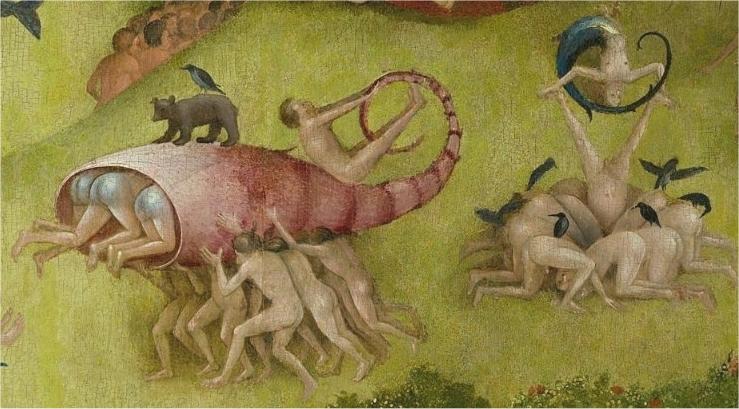








Calas, Elena. Bosch's Garden of Delights: A Theological Rebus. Art Journal, Vol. 29, No. 2 (Winter 1969-70), pp. 184-199.
Elena Calas was the wife of Nicolas Calas, a writer, political activist and member of Breton's Surrealist movement. He received grants from the Bollingen Foundation (1949-1951) to write a study of the triptych The Garden of Earthly Delights by Hieronymus Bosch but failed to get it published and continued rewriting the manuscript until his death. William Carlos Willams was impressed by Calas'
“passionate application” and success in “mak[ing] Bosch’s mind work as if it were a contemporary mind (and we know the mind has always worked the same): he gives Bosch a contemporaneity we cannot ignore”. Calas’s argument that this polemical, parabolic painting pictorialises the writings of St Gregory and St Augustine by way of exposure of some of the heresies of his day relies on a method of meticulous decoding, which, however, amounts to more than scholarly explication. As Williams puts it: “It is rather an evocation in which the present mind brings the past up to today and makes it work before our eyes. It is an eye cast into Bosch’s mind, true enough, but it is also our eyes and mind which we lend to the past that it may live again as we watch it performing, alive before us. Calas lends Bosch his faculties and bids him speak”.According to Nicolas Calas, the over-all theme of Bosch's triptych [Garden of Earthly Delights] comes from St. Augustine's interpretation of an early version of Psalm 33 which describes the Creation and warns of a horrible end for the ungodly. His unpublished manuscripts are preserved in the Nordic Library in Athens.
- Vassiliki Kolocotroni in Minotaur in Manhattan: Nicolas Calas and the Fortunes of Surrealism.
Nicolas's wife Elana had written an article drawing on her husband's work on Bosch. In this she presents in some detail the idea that Bosch was deeply learned, and used his art to illustrate obscure parts of the theology of St. Augustine, using complex puns in Greek and Latin. An example of this would be her analysis of an image from the right centre of the Central panel:

" The most complex of the groupings (far right) is the central one which includes a mermaid, the tail and the Y motifs reappearing with her: she is held aloft by the tail which is supported by an inverted body whose legs form a Y; the body rises from a circle of exposed posteriors with blackbirds pecking at the anuses. We conjecture: the Y position of the legs of the overturned body is a reference to Hyades "named from the Greek letter which rendered by Y", the strangely bloated belly may allude to the pun gaster-aster, (i.e. belly-star) while the entity spells out oura-anus (oura Greek: tail; ouranos: sky).This is so complex as to have become almost meaningless. Imagine if poor old Bosch had to study St. Augustine and work out all these complex puns before beginning to paint his images. I doubt he could even have begun the painting, he would be so confused and muddled by the many permutations and interweaving of all these puns shifting from Greek to Latin. Bosch would have been paralysed by his subtext.
Just to the left of the oura-anus cluster, the small bear atop Scorpio's tail represents Arcturus, arktos meaning both bear and North in Greek, while the backsides framed in Scorpio's tail possibly allude to nola-noton, meaning buttocks and South.
We recognize "the Martyrs" - deriving from the Greek for witnesses, i.e. martyres in the men under the emblem of the long- tailed dragon at the extreme right who are witnessing a celestial vision represented by the ouranos cluster and are pointing to it. We might note still another version of Arcturus "turned about and set on high" in the small detail of the overturned bear borne shoulder-high by men in front of the third edifice.
The rude charade spelling out Ouranos—Uranus when translated into Latin — is in keeping with the spirit of the scene presented in the fountain aperture: the libertine hand on the mound of Venus serving to indicate the sign of Venus. Ouranos, according to Plato, is the father of the celestial or Uranian Aphrodite-Venus."
How can a intelligent person put forward such an interpretation which which relied on Bosch being so well read in Greek and Latin theology? The man was a painter not a theologian and scholar. Erasmus himself would have struggled to create such punning. Bosch was daily concerned with the problems of painting, not sitting at a desk reading complex messages out of theological texts.






